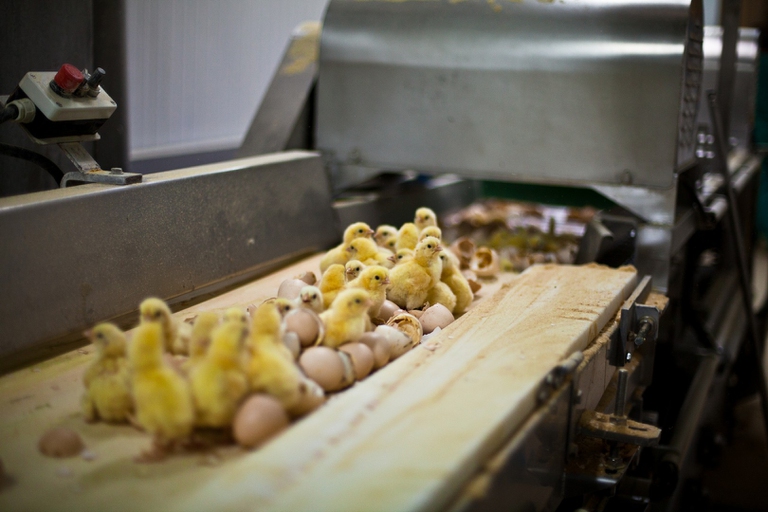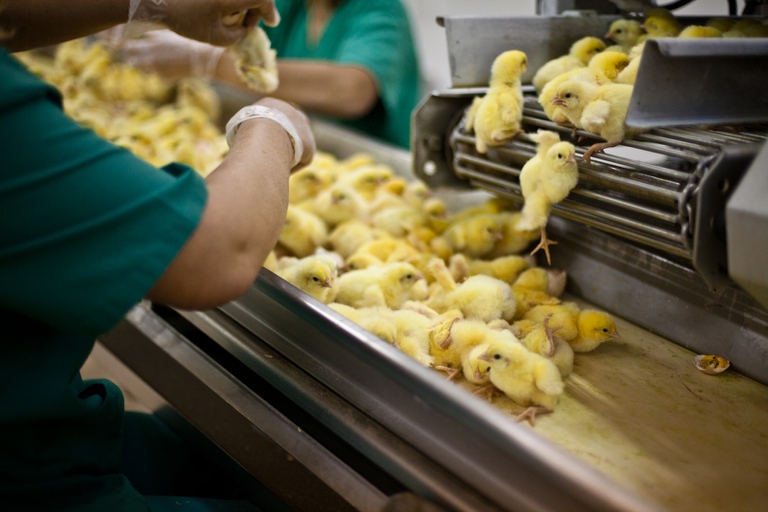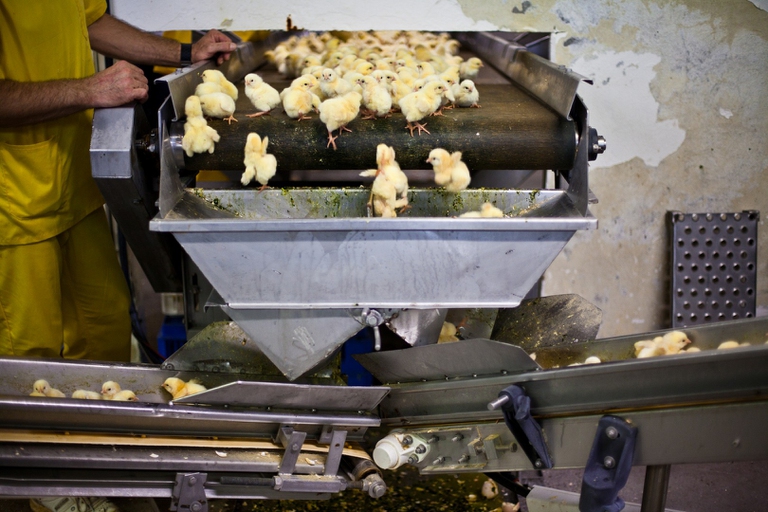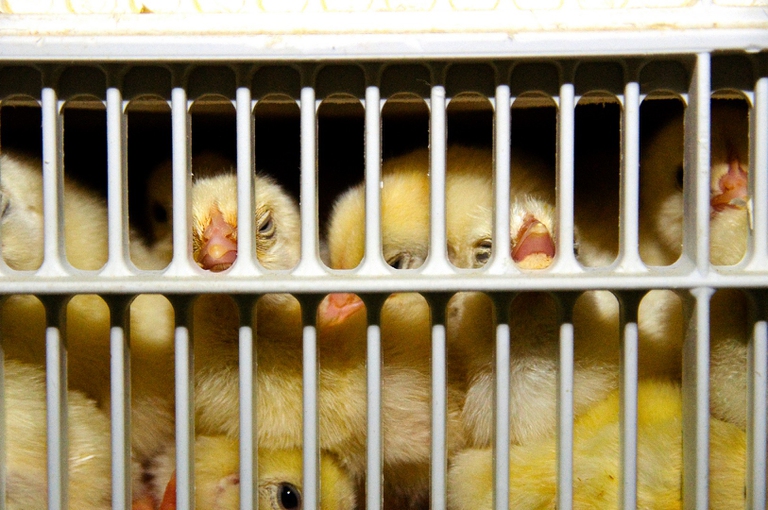
A new travelling exhibition, which is being shown in various parts of the Andean country Ecuador, seeks to make the important work of Ecuadorian women scientists visible. Because women need science and science needs women.
Considered useless, billions of male chicks are killed every year by the egg industry using cruel methods. But consumers can demand more humane practices.
Every year, billions of male chicks are killed around the world by industrial agricultural farmers in the egg industry: they’re considered useless by both egg and poultry producers since they don’t lay eggs and their breed isn’t used for meat production. In the United States alone, around 260 million male chicks are killed yearly. This means that over 30,000 freshly hatched chicks die every hour in the country.
The fact that newly born chicks are routinely slaughtered is bad enough, but this is further aggravated by the extremely cruel killing techniques used, such as gassing, suffocation and electrocution. One of the most common methods used is maceration — or grinding chicks alive — whereby the baby birds are transferred to a grinding machine and are killed by “shredding”. It should be stressed that the chicks are fully conscious while their bodies are being ground up.
Animal Equality’s shocking investigation into industrial chicken hatcheries shows just how callously chickens are treated in the food industry. Hatcheries exploit chicks in unnatural conditions, with babies being mistreated inside industrial complexes their first day of life before being sent to factory farms. These animals will never know the love or warmth of their mothers.
The investigation’s footage documents baby chicks being thrown into the trash while still alive, workers attempting to kill them by tearing their heads off and many chicks dying while being transported to farms. This cruelty is just one example of what happens to chickens in the food industry, a business in which approximately 50 billion chickens are killed around the world — a number that excludes male chicks and unproductive hens “disposed of” in egg production.
Egg companies are infamous for selling their products as “cage-free” or “humane raised”. Unfortunately, as Animal Equality’s investigations have shown time and time again, chickens in the industry are subject to a never-ending cycle of abuse and suffering. For example, male chick culling happens in nearly 100 per cent of US egg production supply chains. This means that even eggs marketed as “humane” are produced through this highly inhumane practice. No reasonable consumer would assume that eggs touted as “humane” would entail the use of brutal chick culling methods, like grinding them up alive or suffocating them in trash bags.
Even though chick culling isn’t prohibited in many countries, including the US, it can still lead to legal troubles for egg companies. Consumers who purchase eggs labeled as “humane” aren’t getting what they think they’re paying for. Marketing eggs as being superior because they’re “humane” could be considered false advertising and could violate countries’ regulations if those claims mislead consumers into purchasing behaviours based on untrue claims.
Thankfully, technological advances may be able to end some of the egg industry’s most abhorrent practices. In-ovo sexing technology can be used to detect the sex of chicks in their embryonic state, allowing producers to prevent the development and subsequent death of male chicks. These systems use intelligent trays or laser systems to recognise the sex of the egg’s embryo, allowing male or unfertilised eggs to be discarded. After many years of development, this technology is now available and ready to be implemented on a large scale.
Thanks to these revolutionary developments, countries have started banning the practice of male chick culling. France passed a ban due to start in 2021 last year, Germany announced its plans to end the practice by 2022 and Spain is also close to announcing a similar ban. Thanks to a campaign by Animal Equality, the trade association that represents Italy’s major egg producers, Assoavi, has also committed to working to eliminate routine mass culling in the egg industry.
Animal Equality has been working tirelessly across the globe to end chick culling, with campaigns currently running in Italy, Brazil and the US which have garnered thousands of signatures from people who universally agree that the practice of male chick slaughter by industrial egg producers is a violent, unnecessary step in an already cruel industry – and must end immediately.
Until it does, compassionate people must use their voice to tell egg producers that enough is enough. To make a difference, consider signing Animal Equality’s petition to end the practice in the US, and please leave eggs off your plate.
Siamo anche su WhatsApp. Segui il canale ufficiale LifeGate per restare aggiornata, aggiornato sulle ultime notizie e sulle nostre attività.
![]()
Quest'opera è distribuita con Licenza Creative Commons Attribuzione - Non commerciale - Non opere derivate 4.0 Internazionale.
A new travelling exhibition, which is being shown in various parts of the Andean country Ecuador, seeks to make the important work of Ecuadorian women scientists visible. Because women need science and science needs women.
Meet Gokul Subedi and Prakriti Mainali, the founders of two humanitarian organisations with one shared goal: to improve the lives of the most vulnerable and disadvantaged members of Nepalese society.
The Hijab ban has caused a major controversy in India after several Muslim girls were denied entry into a college for wearing the traditional headscarf.
Brazil’s Supreme Federal Court has indefinitely shelved a case that was set to drastically alter indigenous land right claims, leaving its fate uncertain.
Animal Equality reveals the brutality of Europe’s pig meat industry and illegal activities on farms for which many perpetrators haven’t yet been punished.
Jenu Kuruba, a honey-collecting indigenous tribe of India, accuses the local government of forcefully evicting them from the forest that is their home.
The state of women’s rights in Turkey is critical, and gender-based violence is increasing. The country’s withdrawal from the Istanbul Convention will only make matters worse.
One in three women have suffered physical or sexual violence. With contributions from Europe, Africa, Asia and Latin America, we look at how this shadow pandemic affects every corner of the world.
The Istanbul Convention against gender-based and domestic violence marks its tenth anniversary. We look at what it is, who its signatories are, and what the future might hold.











